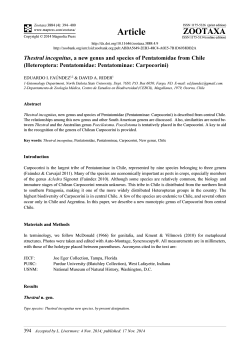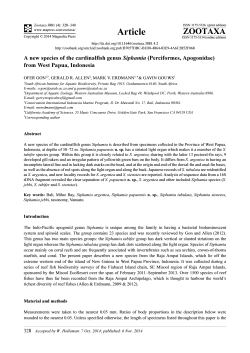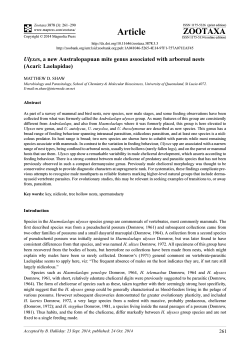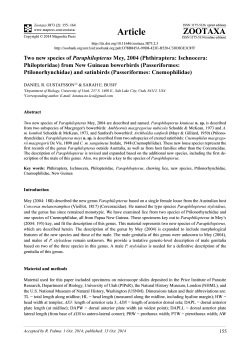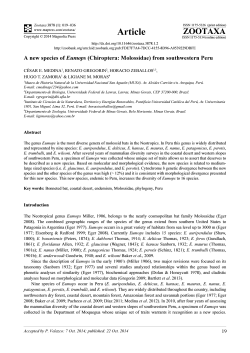
Preview - Magnolia Press
Zootaxa 3946 (4): 510–518 www.mapress.com /zootaxa / Copyright © 2015 Magnolia Press Article ISSN 1175-5326 (print edition) ZOOTAXA ISSN 1175-5334 (online edition) http://dx.doi.org/10.11646/zootaxa.3946.4.2 http://zoobank.org/urn:lsid:zoobank.org:pub:5ACF3615-12A9-46FA-8950-4506692DCDEB A new genus and species of delphacid planthopper (Hemiptera: Fulgoroidea: Delphacidae) from Central America with a preliminary regional species list CHARLES R. BARTLETT1 & GERNOT KUNZ2 University of Delaware, Department of Entomology and Wildlife Ecology, 250 Townsend Hall, Newark, Delaware, 19716-2160, USA. E-mail: Bartlett@udel.edu 2 Karl-Franzens-Universität, Universitätsplatz 2, Zoologie, 8010 Graz, Austria. E-mail: gernot.kunz@gmail.com Abstract The new genus Ampliphax, assigned to the Delphacini, is described and illustrated with a single new species A. grandis from Costa Rica and Panama. Ampliphax grandis is a large species with a projected head. DNA barcode data suggest, among currently barcoded taxa, an affinity to the genus Bostaera. A checklist of the delphacid species from Costa Rica, Panama, and Nicaragua based on literature and specimen records is provided. Key words: Delphacidae, Delphacini, Fulgoroidea, Auchenorrhyncha, planthopper, new species, Central America Introduction Delphacidae is a diverse group (2,100+ species) of small planthoppers, with several species of economic importance in the Neotropics, including the corn delphacid, Peregrinus maidis (Ashmead), the rice-feeding Tagosodes orizicolus (Muir) and T. cubanus (Crawford), the adventive sugarcane planthopper, Perkinsiella saccharicida Kirkaldy, and Saccharosydne saccharivora (Westwood), a native sugarcane disease vector (e.g., Arocha et al. 2005). Despite their importance, the Neotropical Delphacidae remains poorly investigated. There are no modern faunistic reviews and undescribed species are readily detected amidst new collections, unsorted institutional collections, or among faunistic photographs. Among described species, distributional information remains incompletely reported. Here, an unusual delphacid in the tribe Delphacini (Delphacinae) is described and illustrated from Costa Rica and Panama. Costa Rica is unusual among Mesoamerican countries in that substantive effort has been made to investigate the insect fauna, and an extensive collection of Hemiptera is available at the National Biodiversity Institute (INBio). A recent project at INBio has DNA barcoded 285 Delphacidae from the INBio collection, putatively representing 44 taxa. These data are available online at Barcode of Life (BOLD; http:// www.barcodeoflife.org/; Ratnasingham & Hebert 2007, 2013), and include 3 specimens of the unusual new genus and species described here. As of this writing, BOLD has a total of 1,261 delphacid specimens with barcodes representing 287 species. This new genus is assigned to the Delphacini (Delphacinae) because the calcar is large, tectiform, and flattened, bearing a row of fine, black-tipped teeth on the posterior margin; the genital diaphragm is well-developed (including a remarkably large armature), and an elongate suspensorium attaches segment X to the base of the aedeagus, which is represented by a simple tubular fused theca. It was originally found in collections from Costa Rica and subsequently Panama. Also, a preliminary list of delphacid species from Nicaragua, Costa Rica, and Panama is provided and discussed. Materials and methods Specimens were examined from the following collections (abbreviations following Arnett et al. 1993): 510 Accepted by A.-P. LIANG: 16 Mar. 2015; published: 13 Apr. 2015 (Instituto Nacional de Biodiversidad, Costa Rica) for loans of specimens and for providing information regarding specimens in the INBio collection and the INBio BOLD project. We thank Ashley Kennedy (University of Delaware) for review of this manuscript. We thank Kimberley Shropshire for specimen photography, measurements, and line artwork. Support for this research for was provided by the USDA Agriculture and Food Research Initiative Competitive Grants Program Grant No. 2009–55605–05006 from the National Institute of Food and Agriculture, NSF Advancing Digitization of Biological Collections (ADBC) award 1115103 (Digitization TCN: Collaborative Research: Plants, Herbivores, and Parasitoids: A Model System for the Study of Tri-Trophic Associations), and Hatch Project W-3185 Biological Control in Pest Management Systems of Plants, with additional support from the University of Delaware Department of Entomology and Wildlife Ecology. References Arnett, R.H. Jr., Samuelson, G.A. & Nishida, G.M. (1993) The Insect and Spider Collections of the World. 2nd Edition. Sandhill Crane Press, Gainesville, Florida, 310 pp. Arocha, Y., López, M., Fernández, M., Piñol, B., Horta, D., Peralta, E.L., Almeida, R., Carvajal, O., Picornell, S., Wilson, M.R. & Jones, P. (2005) Transmission of a sugarcane yellow leaf phytoplasma by the delphacid planthopper Saccharosydne saccharivora, a new vector of sugarcane yellow leaf syndrome. Plant Pathology, 54, 634–642. http://dx.doi.org/10.1111/j.1365-3059.2005.01242.x Arthropod Easy Capture (2013) Arthropod Easy Capture, Version: 1.34. Available from: https://sourceforge.net/projects/ arthropodeasy (accessed 4 September 2013) Asche, M. (1985) Zur Phylogenie der Delphacidae Leach, 1815 (Homoptera: Cicadina: Fulgoromorpha). Marburger Entomologische Publikationen, 2 (1), Vol. 1 & 2, 1–398 & 399–910. Asche, M. (1990) Vizcayinae, a new subfamily of Delphacidae with revision of Vizcaya Muir (Homoptera: Fulgoroidea) - a significant phylogenetic link. Bishop Museum Occasional Papers, 30, 154–187. Asche, M. & Wilson, M.R. (1990) The delphacid genus Sogatella and related groups: a revision with special reference to rice associated species (Homoptera: Fulgoroidea). Systematic Entomology, 15, 1–42. http://dx.doi.org/10.1111/j.1365-3113.1990.tb00301.x Barringer, L.E. & Bartlett, C.R. (2011) A review of New World Asiracinae (Hemiptera: Auchenorrhyncha: Delphacidae) with five new taxa. Cicadina 12, 7–39. Bartlett, C.R. (2007) A review of the planthopper genus Nilaparvata (Hemiptera: Delphacidae) in the New World. Entomological News, 118, 49–66. http://dx.doi.org/10.3157/0013-872X(2007)118[49:AROTPG]2.0.CO;2 Bartlett, C.R. (2010) Diversity in New World Stenocranine planthoppers (Hemiptera: Delphacidae). Transactions of the American Entomological Society, 135, 443–486. [dated 2009] http://dx.doi.org/10.3157/061.135.0407 Bartlett, C.R. (2014) New species of the planthopper genus Parkana (Hemiptera: Fulgoroidea: Delphacidae) from Mesoamerica. Transactions of the American Entomological Society, 140, 185–208. Bartlett, C.R. & Deitz, L.L. (2000) Revision of the New World delphacid planthopper genus Pissonotus (Hemiptera: Fulgoroidea). Thomas Say Publications in Entomology, Monographs, 1–234. Bartlett, C.R., O’Brien, L.B. & Wilson, S.W. (2014) A review of the planthoppers (Hemiptera: Fulgoroidea) of the United States. Memoirs of the American Entomological Society, 50, 1–287. Bourgoin, T. (2014) FLOW (Fulgoromorpha Lists on The Web): a world knowledge base dedicated to Fulgoromorpha. Version 8, updated Feb. 25, 2014. Available from: http://hemiptera-databases.org/flow/ (accessed 28 February 2014) Bourgoin, T., Wang, R.-R., Asche, M., Hoch, H., Soulier-Perkins, A., Stroiński, A., Yap, S. & Szwedo, J. (2015) From micropterism to hyperpterism: recognition strategy and standardized homology-driven terminology of the forewing venation patterns in planthoppers (Hemiptera: Fulgoromorpha). Zoomorphology, 134, 63–77. http://dx.doi.org/10.1007/s00435-014-0243-6 Crawford, D.L. (1914) A contribution toward a monograph of the homopterous insects of the family Delphacidae of North and South America. Proceedings of the United States National Museum, 46, 557–640. http://dx.doi.org/10.5479/si.00963801.46-2041.557 Dworakowska, I. (1988) Main veins of the wings of Auchenorrhyncha (Insecta, Rhynchota: Hemelytrata). Entomologische Abhandlungen Staatliches Museum für Tierkunde Dresden, 52, 63–108. Emeljanov, A.F. (1977) Homology of wing structures in Cicadina and primitive Polyneoptera. Terminology and homology of venation in insects. Trudy Vsesoyuznogo Entomologicheskogo Obshchestva, 58, 3–48. [in Russian] Emeljanov, A.F. (1987) Phylogeny of Cicadina (Homoptera) on comparatively morphological data. Trudy Vsesoyuznogo Entomologicheskogo Obshchestva, 69, 19–109. [in Russian] Fennah, R.G. (1944) The morphology of the tegmina and wings of the Fulgoroidea (Homoptera). Proceedings of the Entomological Society of Washington, 46, 185–199. A NEW DELPHACID PLANTHOPPER FROM CENTRAL AMERICA Zootaxa 3946 (4) © 2015 Magnolia Press · 517 Fennah, R.G. (1964) New species of Ugyops (Fulgoroidea: Delphacidae) from South America and South-east Asia. Bulletin of the British Museum (Natural History) Entomology, 15. 117–143. Fowler, W.W. (1905) Order Rhynchota. Suborder Hemiptera-Homoptera. (Continued). Biologia Centrali-Americana, 1, 125– 139, plate 13. Gonzon, A.T. Jr. & Bartlett, C.R. (2008) Systematics of Hadropygos n. g., Metadelphax Wagner and New World Toya Distant (Hemiptera: Delphacidae). Transactions of the American Entomological Society, 133, 205–277. [dated 2007] http://dx.doi.org/10.3157/0002-8320-133.3.205 Hedrick-Zeller, M.M. & Wilson, S.W. (2010) The planthopper genus Pentagramma in the United States: morphology of the male and female genitalia (Hemiptera: Delphacidae). Journal of the Kansas Entomological Society, 83, 231–239. http://dx.doi.org/10.2317/JKES0911.10.1 Kennedy, A.C. & Bartlett, C.R. (2014) Systematics of Caenodelphax Fennah (Hemiptera: Fulgoroidea: Delphacidae) and description of the new genus Flavoclypeus. Transactions of the American Entomological Society, 140, 17–65. Kramer, J.P. (1973) Revision of the American planthoppers of the genus Stobaera (Homoptera: Delphacidae) with new distributional data and host plant records. Proceedings of the Entomological Society of Washington, 75, 379–402. Kukalová-Peck, J. (1983) Origin of the insect wing and wing articulation from the arthropodan leg. Canadian Journal of Zoology, 61, 1618–1669. http://dx.doi.org/10.1139/z83-217 Maes, J.M. (1992) Fauna entomologica del Departamento de Zelaya, Nicaragua (Segunda nota). Revista Nicaraguense de Entomologia, 19, 29–41. Maes, J.M. (2004) Insectos asociados a algunos cultivos tropicales en el Atlantico de Nicaragua. parte IX: Coco (Cocos nucifera, Arecaceae). Revista Nicaraguense de Entomologia, 64 (supplement 1, part 9), 1–88. Maes, J.M. & O'Brien, L.B. (1988) Catalogo de los Fulgoroidea (Homoptera) de Nicaragua. Revista Nicaraguense de Entomologia, 2, 27–42. Maes, J.M. & Tellez Robleto, J.S. (1988) Catálogo de los insectos y artrópodos terrestres asociados a las principales plantas de importancia económica en Nicaragua. Revista Nicaraguense de Entomologia, 5, 1–95. Metcalf, Z.P. (1938) The Fulgorina of Barro Colorado and other parts of Panama. Bulletin of the Museum of Comparative Zoology, Harvard College, 82, 277–423. Metcalf, Z.P. (1943) General Catalogue of the Hemiptera. Fascicle IV, Fulgoroidea, Part 3, Araeopidae (Delphacidae). Smith College, Northhampton, Massachusetts, 552 pp. Muir, F.A.G. (1926) Contributions to our knowledge of South American Fulgoroidea (Homoptera). Part I. The family Delphacidae. Experiment Station of the Hawaiian Sugar Planters’ Association, Entomological Series, Bulletin 18, 1–51, plates 1–5. Nel, A., Prokop, J., Nel, P., Grandcolas, P., Huang, D.Y., Roques, P., Guilbert, E., Dostál, O. & Szwedo, J. (2012) Traits and evolution of wing venation pattern in paraneopteran insects. Journal of Morphology, 273, 480–506. http://dx.doi.org/10.1002/jmor.11036 Ratnasingham, S. & Hebert, P.D.N. (2007) BOLD: The Barcode of Life data system (www.barcodinglife.org). Molecular Ecology Notes, 7, 355–364. http://dx.doi.org/10.1111/j.1471-8286.2007.01678.x Ratnasingham, S. & Hebert, P.D.N. (2013) A DNA-based registry for all animal species: The Barcode Index Number (BIN) system. PLoS ONE, 8 (8), e66213. http://dx.doi.org/10.1371/journal.pone.0066213 Schuh, R.T. (2012) Integrating specimen databases and revisionary systematics. ZooKeys 209: 255–267. http://dx.doi.org/10.3897/zookeys.209.3288 Schuh, R.T., Hewson-Smith, S. & Ascher, J.S. (2010) Specimen databases: A case study in entomology using Web-based software. American Entomologist, 56, 206–216. http://dx.doi.org/10.1093/ae/56.4.206 Shorthouse, D.P. (2010) SimpleMappr, an online tool to produce publication-quality point maps. Retrieved from http:// www.simplemappr.net. (accessed 07 August 2014) Urban, J.M., Bartlett, C.R. & Cryan, J.R. (2010) Evolution of Delphacidae (Hemiptera: Fulgoroidea): Combined-evidence phylogenetics reveals importance of grass host shifts. Systematic Entomology, 35, 678–691. http://dx.doi.org/10.1111/j.1365-3113.2010.00539.x Van Duzee, E.P. (1933) The Templeton Crocker Expedition of the California Academy of Sciences, 1932. No. 4. Characters of twenty-four new species of Hemiptera from the Galapagos Islands and the coast and islands of Central America and Mexico. Proceedings of the California Academy of Sciences, Series 4, 21, 25–40. Wilson, S.W. (2005) Keys to the families of Fulgoromorpha with emphasis on planthoppers of potential economic importance in the southeastern United States (Hemiptera: Auchenorrhyncha). Florida Entomologist, 88, 464–481. http://dx.doi.org/10.1653/0015-4040(2005)88[464:KTTFOF]2.0.CO;2 Wilson, S.W. & McPherson, J.M. (1980) Keys to the planthoppers, or Fulgoroidea of Illinois (Homoptera). Transactions of the Illinois State Academy of Science, 73 (2), 1–61. 518 · Zootaxa 3946 (4) © 2015 Magnolia Press BARTLETT & KUNZ
© Copyright 2025

